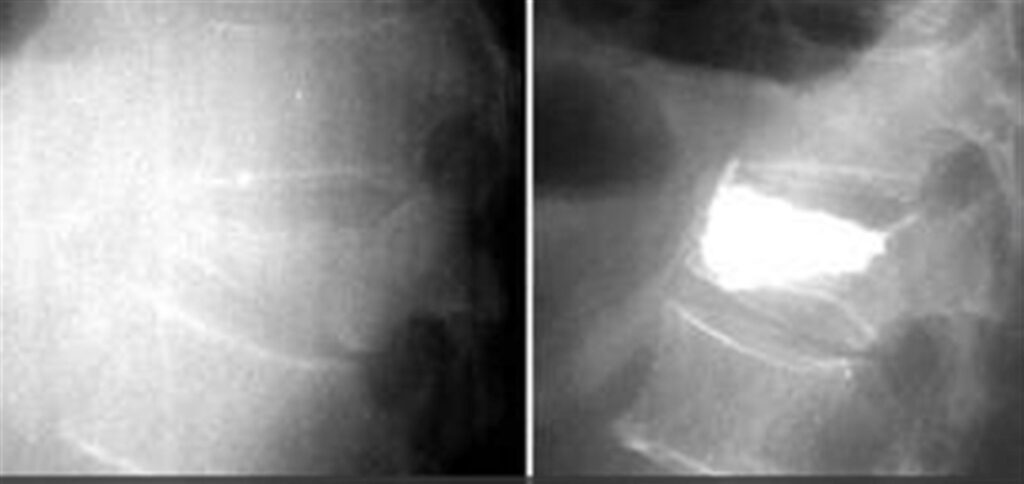
Osteoporotic Fracture Kyphoplasty Vertebroplasty
Osteoporotic Fracture Kyphoplasty Vertebroplasty
Kyphoplasty and vertebroplasty are minimally invasive procedures used to treat vertebral compression fractures, often caused by osteoporosis or cancer.
Both involve injecting special cement into the vertebrae to stabilize fractures and relieve pain. However, kyphoplasty includes an additional step of using a balloon-like device to create space within the vertebra before cement injection, allowing for restoration of vertebral height.
They are typically recommended for individuals experiencing pain or spinal deformity due to vertebral compression or collapse. It’s important to discuss the risks and benefits of these procedures with Dr Arjun R H H to determine the most suitable treatment option.
Common reasons for undergoing osteoporotic fracture kyphoplasty or vertebroplasty include vertebral compression fractures resulting from osteoporosis, characterized by weakened bones prone to fracture.
These fractures often cause sudden or gradual collapse of the vertebrae, leading to pain and spinal deformity. Individuals experiencing persistent or severe pain that does not respond to conservative treatments such as pain medication may opt these procedure.
Kyphoplasty and vertebroplasty aim to restore vertebral height, improve spinal alignment, and alleviate symptoms, enhancing mobility and quality of life for individuals with osteoporotic vertebral fractures.
Our Spine Surgeon Dr. Arjun R H H will assess your condition thoroughly before surgery to determine the most suitable course of action.
Minimally invasive spine surgery is typically performed using specialized instruments and techniques that allow the surgeon to access the spine through small incisions.
These procedures often utilize fluoroscopy or other imaging techniques to guide the surgeon’s instruments to the precise location.
By minimizing damage to surrounding tissues, muscles, and nerves, this approach aims to reduce pain, scarring, and recovery time for the patient.
Following osteoporotic fracture kyphoplasty or vertebroplasty surgery, the recovery period typically involves spending a few days in the hospital for monitoring and pain management.
Patients can expect to gradually resume light activities within a few weeks but should avoid heavy lifting or strenuous exercise during this time. Physical therapy/exercises often begins shortly after surgery to promote mobility, strengthen muscles, and aid in recovery, continuing for several weeks to months.
Complete recovery may take several months, during which patients gradually increase activity levels under the guidance of their surgeon. Regular follow-up appointments are important to monitor progress and ensure optimal healing. It’s crucial for patients to adhere to post-operative instructions to minimize complications and support a smooth recovery process.
The risks of osteoporotic fracture kyphoplasty and vertebroplasty surgery include cement leakage, which can lead to nerve irritation, spinal cord compression, or pulmonary embolism.
There is also a risk of adjacent vertebral fractures due to increased stiffness of treated vertebrae. Some individuals may experience allergic reactions to the bone cement or anesthesia-related complications. Additionally, there’s a possibility of failure to relieve symptoms effectively, necessitating further interventions. Rare complications such as blood clots or pulmonary complications may also occur.
It’s essential for patients to discuss these risks with Dr Arjun R H H to make informed decisions about treatment options.
The benefits of osteoporotic fracture kyphoplasty and vertebroplasty include effective pain relief, often providing immediate and significant reduction in pain associated with vertebral compression fractures. Both procedures stabilize fractured vertebrae, reducing the risk of further collapse and deformity, thereby improving vertebral stability.
Kyphoplasty, in particular, can restore vertebral height, enhancing spinal alignment and reducing kyphotic deformity, which can improve posture. By reducing pain and stabilizing fractures, these minimally invasive procedures enhance overall function, allowing patients to return to daily activities more quickly. Additionally, they involve smaller incisions, less blood loss, and faster recovery compared to traditional open surgery.
The pain relief provided may also reduce the need for pain medications, improving overall quality of life for patients. By preventing further complications such as spinal cord compression or neurological deficits, kyphoplasty and vertebroplasty can help maintain long-term spinal health and function for individuals with osteoporotic vertebral fractures.
Dr. Arjun R. H. H typically evaluates the necessity for osteoporotic fracture kyphoplasty and vertebroplasty using a combination of methods, including physical examination, imaging tests such as MRI, and a review of the patient’s medical history.
During the physical examination, Dr. Arjun R H H assesses strength, sensation, reflexes, and symptoms like pain and mobility limitations in the affected area.
Imaging tests, particularly MRI, help pinpoint the location and severity of spinal issues like disc degeneration or instability, and whether they are causing nerve compression. Based on these evaluations, Dr. Arjun H H determines if osteoporotic fracture kyphoplasty and vertebroplasty is the suitable treatment option for the patient’s condition.
The typical duration of an osteoporotic fracture kyphoplasty or vertebroplasty procedure is relatively short, typically lasting between 2 to 3 hours. This duration includes pre-operative preparation, such as positioning and anesthesia administration, as well as the actual procedure, which involves the insertion of needles or balloons into the fractured vertebrae followed by the injection of bone cement.
The number of vertebrae treated during a single session may vary depending on the extent and location of fractures, but each treated vertebra usually adds minimal additional time to the overall procedure. After the procedure, patients typically spend some time in the recovery room for observation before being discharged.
However, the exact duration can be influenced by individual patient factors and any unforeseen complications that may arise during the procedure.
In many cases, patient may go home on the same day of the surgery, once they have recovered from the anesthesia and are considered stable by the medical team.
However, some patients may require an overnight stay for observation or if there are any concerns about their recovery. Overall, the duration of hospital stay following Osteoporotic Fracture Kyphoplasty Vertebroplasty surgery depends on factors such as the patient’s overall health, the extent of the surgery, and the surgeon’s recommendations.
After Osteoporotic Fracture Kyphoplasty Vertebroplasty surgery, maintaining a healthy spine involves a combination of medications, exercises, and lifestyle modifications.
For a safe and effective recovery, Dr Arjun R H H will prescribes medications to manage pain and inflammation during the recovery period.
Additionally, Doctor will recommend specific exercises to strengthen the muscles supporting the spine and improve flexibility. Depending on the patient’s overall condition and specific surgical outcome, the doctor may provide personalized recommendations . For more information and guidance, it’s advisable to consult Spine Surgeon Dr. Arjun R H H.
Views: 0
